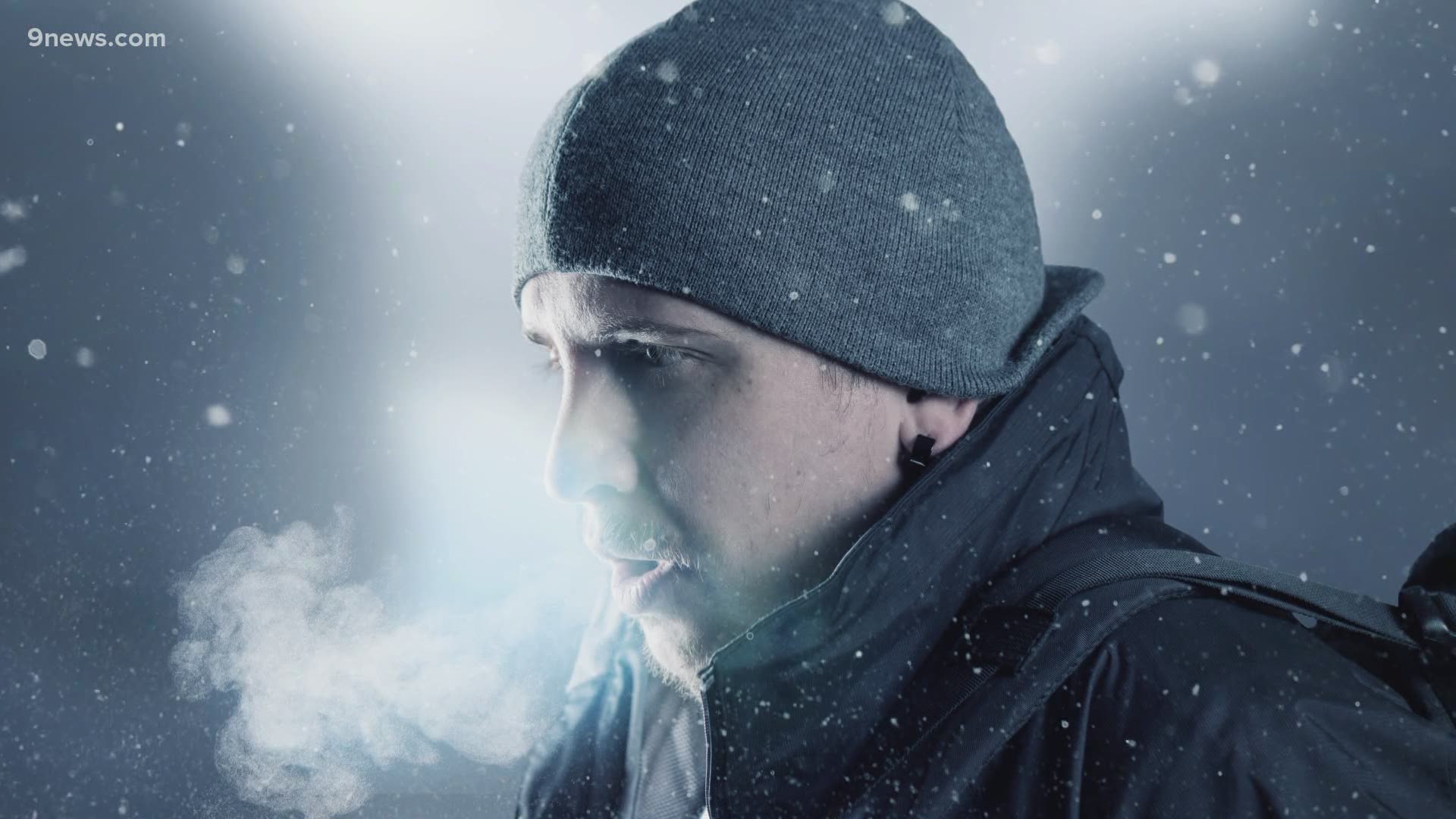COLORADO, USA — The actual air temperatures might not be too dangerous in Colorado during this weekend cold snap, but add in the wind-chill factor and the short-term exposure becomes very dangerous.
Once the temperature gets into the range of -17 or below, that's when exposed skin can become susceptible to frostbite in less than 30 minutes. The forecast wind chills on the Front Range this weekend are from -10 to -20 degrees, and they're -20 to -30 on the eastern plains.
Confusion Over Wind-Chill Factor
The wind-chill factor can be confusing to some people, especially when you hear the term “feels like” mentioned along with the forecast.
That might make you think it’s a different impact to different people.
The wind-chill factor is not a feeling. It is a straight-up mathematical equation that is proportionately equal for all people no matter your size, weight or skin tone.
What is the Wind-Chill Factor
Can a person tell the difference between -5 degrees and -20 degrees? Probably not. When it’s really cold, it’s just really cold.
That's because the wind chill is not a feeling. It's math.
Skin exposed to cold air without any wind chill will cause you to lose your body heat in a certain amount of time.
That amount of time will be different for everyone depending on things like body type, weight and age.
When you add in wind, that accelerates the cooling of a surface.
So, the wind-chill factor tells you how much faster you will lose your body heat due to the additional cooling from the wind. That part of the equation is the same for everyone, no matter what your body type is.
The National Weather Service (NWS) has a chart that makes it easy to calculate the impacts of the wind-chill factor.
For example, if the air temperature is -5, but there is also a 10 mph wind, your body loses heat at the same rate that it would if the temperature was -22 degrees.
Dangers of extremely low wind chill
9NEWS discussed the dangers of low wind-chill temperatures with the emergency room director at the University of Colorado Anschutz, Highlands Ranch, Dr. Ben Usatch. He is also the medical director for Eldora Mountain Resort.
(Editor's note: Answers have been edited for context and clarity.)
How common is frostbite in Colorado? It's not the sort of thing that makes the news.
Very common. We are a serious winter outdoor state, and we treat a lot of frostbite here. In the inner city area, we see a lot of problems with the homeless population getting frostbite. There is a high risk for frostbite in Colorado.
What is frostbite and how dangerous is it?
When your body tissue starts to get cold, it actually progresses in stages, so we grade levels of frostbite. It can get to the point where crystals form on your skin, which is very dangerous. If exposed long enough, part of your body can actually freeze completely.
What parts of your body are the most common frostbite areas?
Mostly we see parts of the face that are exposed to the elements. Ears, nose, cheeks and chin. And we also treat a lot of fingers and toes for frostbite. Those are areas with somewhat decreased circulation.
How can you tell if you have frostbite? Will it be obvious?
Well, it’s obvious to us when you finally hit the emergency room, but the problem is that it can absolutely gradually creep up on you, and you really don’t know what’s going on. So if you’re out there skiing or hiking and you look to your buddy and he’s starting to get ashy pale, waxy skin on the chin or the nose, you have to remove yourself from that environment and rapidly start to warm the affected area.
Can you recover from frostbite?
Our bodies are awesome in general at recovery, and absolutely, yes, you can make a full recovery from frostbite if you catch it in time. There are a lot of factors that go into that, like are you diabetic or have any other type of chronic disease.
What is worst-case scenario with frostbite?
When the tissue actually freezes solid, that's real bad. In particular, if it's in those areas that don't have the best blood flow. When it gets that bad, you may be at the point of no return and end up getting an amputation.
What kinds of situations get people into really bad frostbite cases?
Certainly, the amount of time with exposure makes a big difference. The longer the exposure, usually the worse the frostbite injury. Wind is a big factor. You lose body heat faster if the winds are strong. If your skin is wet for some reason, that will make the cold more intense.
What is hypothermia, and is that a more serious condition?
You get hypothermia when you lose more heat than your body produces. It is a very serious condition. People die of hypothermia all the time.
How do you know whether hypothermia is impacting you?
That's the greatest challenge. You body will not give you quite the cues that you need to make an easy diagnosis. Sometimes the symptoms are similar to other troubles with your body.
In the hypothermic state, you often have some kind of diminished mental capacity, which in itself can make you feel unaware that you are having an issue. Shivering, confusion, slow breathing, low pulse and drowsiness.
SUGGESTED VIDEOS: Local stories from 9NEWS

